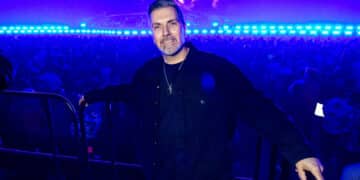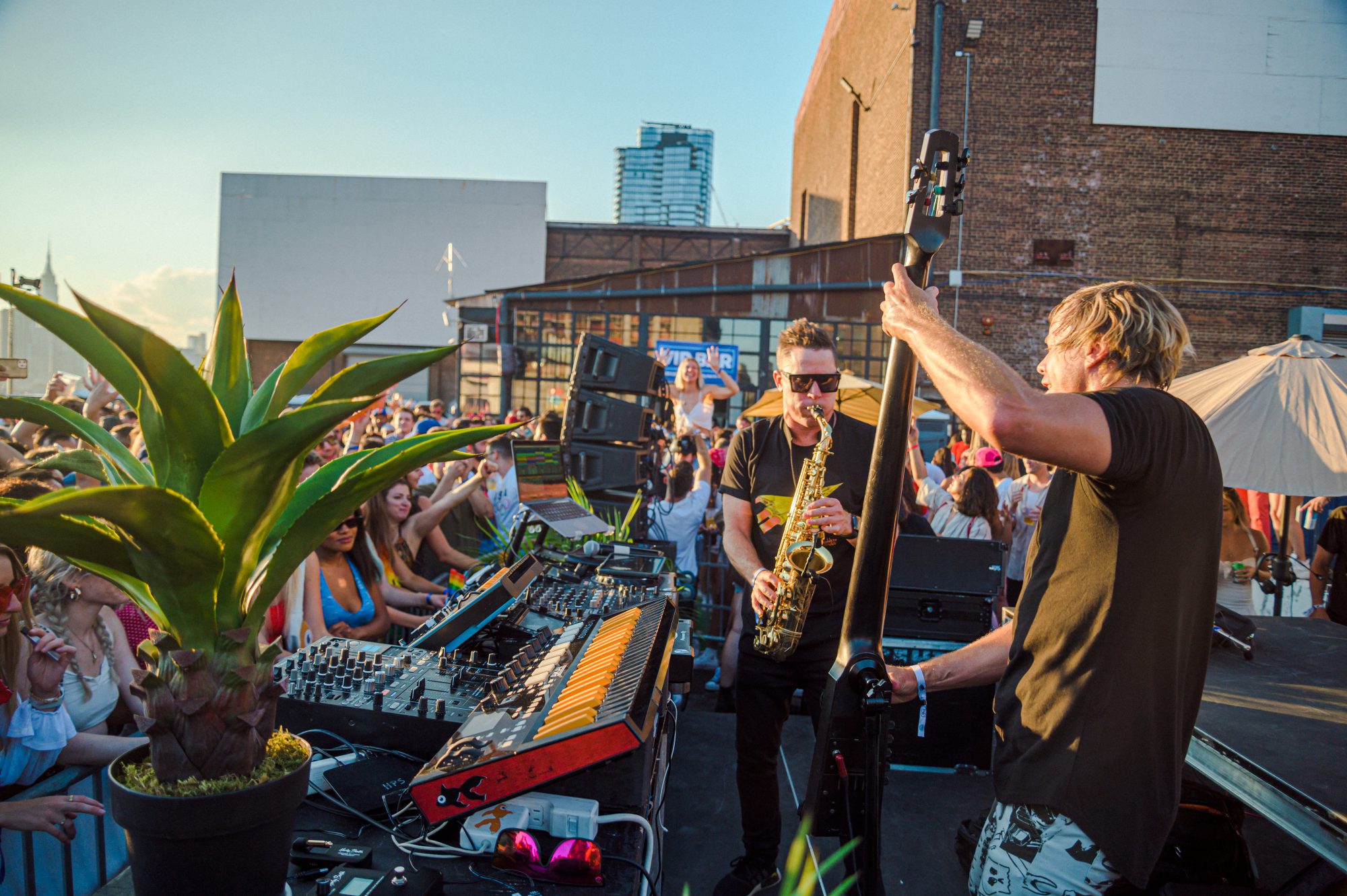Before closing down the wasteLAND stage at EDC Las Vegas, Rob GEE sat down to discuss his backstory, experiences, and more!
While hard dance music was brewing in Europe in the ’90s, Rob GEE was living in the US, DJing hip hop and playing metal music with his bands. It wasn’t until his friends decided to do a “diss” record towards the scene in Rotterdam that he decided to make his own prank record back at them in the realm of 195 BPM hardcore. He redlined the 909 and never looked back, becoming one of the legends in the scene alongside names like Paul Elstak, Partyraiser, and more.
Over his long and illustrious career, Rob GEE has had the honor of playing the biggest festivals in the world like Defqon.1, EDC Las Vegas, Thunderdome, and plenty more. When it comes to hard dance in America, it’s safe to say that Rob GEE is the original pioneer. While many producers were forced to switch their style to create more “radio-friendly” tunes, Rob GEE kept it pushing with his aggressive music that’s been heavily influenced by his love for hardcore metal and hip hop.
Now almost 30 years later, he’s still determined to keep pushing the envelope of hard dance music and at the same time, bring back the classic, old-school gabber vibes that came with the early hardcore movement. More recently, Rob GEE was assigned the task of once again closing down the wasteLAND stage at EDC Las Vegas, and we caught up with him beforehand to discuss his backstory and experiences in the early hardcore scene, the future of the scene through his eyes, and his latest release “1 Gabber Family.” So get ready for a blast-to-the-past, crank up the volume on “1 Gabber Family”, and read on for our full conversation with Rob GEE!
Stream Rob GEE – 1 Gabber Family on Spotify:
You’ve been in the scene for more than 25 years, making records and touring, but I’d like to turn back the clock a little bit. How did you get exposed to hardcore music, and what inspired you to start producing it?
I was there in the beginning. Back in the ‘80s, there was no such thing as Dutch hardcore. Around 1990-1991, there still wasn’t the subgenre “hardcore,” and we would call all rave music techno in America. I’m talking about records like “James Brown is Dead” by L.A. Styles, “Dominator” by Human Resource, and “Mindflux” by N-Joi. I was like, “Wow, what is this amazing music?”
In ‘91/‘92, there were also a few labels in The Netherlands like Rotterdam Records and Mokum Records, which was when the word “hardcore” started to be heard. There was also the word “gabber.” Paul Elstak asked someone in Amsterdam what it meant, and it turned out to mean “friend.” DJ Paul then scratched the word “Gabber” into vinyl, and from there, “hardcore” and “gabber” were now synonymous with this music that had the heavier kickdrums and a little more craziness. That’s how I first got exposed to all of this.
How did your tune “Nonshlentustokken (Ode To Vortex)” open the door for you to fly around the world and dominate the Dutch hardcore scene?
That one was my first track – my first vinyl. “Nonshlentustokken” is something I made up when I took the word “nonsense” and made it sound foreign. So the funny thing about this track is that it was originally just a prank. My friend Damon Wild started a label called War, where they dissed people, but no names were attached to the records.
The first record was called War 1 and featured a track called “Rotterdam Is Full of Sh*t.” Just like European records were coming over to the States, this record made its way to Europe. Of course, some people in Amsterdam loved it because of the little ongoing rivalry between them and Rotterdam, but Rotterdam was pissed!
I hung out with Damon and went to his studio because I wanted to make a prank record that would be the retaliation record to his retaliation record. I started doing this voice you hear in the song and calling everyone out, including club Limelight, Damon Wild, and DJ rePete. I turned it up to 195 BPM and overloaded the 909.
The first version of this record was only a minute and a half because it was never meant to be a real record. When I finished, I called DJ rePete. I told him that I went to the store and found a record with a cartoon of the Limelight club with Lord Michael on a cross, rePete getting beat up by some guy in wooden shoes, and people putting tulips in Damon’s butt. Damon, rePete, and I eventually went to get some pizza, and I couldn’t keep it together. rePete said, “This is really messed up. This is not good at all.” I finally told him that it was not Rotterdam, and it was me. I sang the vocals to him, and he said, “Oh my gosh!”
That same Friday, we went to Limelight with my prank cassette. At this time, Limelight was one of New York’s hottest clubs, so everyone was there, from Wall Street to actors to musicians. We played my record, and the place went crazy! We rewound the tape to play it again, and the crowd went even crazier! After this, I was asked to go to the studio and make a full version of my prank record.
The crazy thing about this record, and it’s giving me goosebumps thinking about it, is that Thunderdome licensed the song and put it as track one on Thunderdome III. Before this, nobody knew who I was, and I wasn’t traveling to play shows or anything.
Paul Elstak heard this record and booked me for my first international show in Rotterdam, not even knowing that “Nonshlentustokken (Ode To Vortex)” was a diss record back to the people who did “Rotterdam Is Full of Sh*t.” It was me sticking up for Rotterdam but also trying to prank my friend at the same time. If they didn’t make that initial diss record, I never would have made my diss record back.
Back in 2006, you brought your “Super Band” to Sensation Black to play a set that was a fusion of Metal and Hardcore music, and nobody had ever done this before. Can you recall the initial reaction to this set, considering how different it must have been to the crowd in the Netherlands at the time?
First of all, that performance probably shouldn’t have taken place at Sensation Black. It should’ve happened at Masters of Hardcore or Thunderdome. They would’ve understood if it was a hardcore crowd because my music already had guitars, but this was a hardstyle crowd. Duncan Stutterheim, who at the time owned ID&T, asked me to play Sensation Black under the condition that I play none of my hits and shock the crowd with the new music I was working on with Slipknot, Biohazard, and System of A Down members. I didn’t think it was going to go over well.
We finally went on to play, and I would say it was a very split crowd. About 20,000 people hated it, but the other half enjoyed it. You could simultaneously hear cheers and boos. Also, some guy climbed on stage that night. We did what we had to do, Jersey style. They arrested him, but then they arrested me too and locked me up for a few hours along with my MC. Looking back, I think many people still would’ve hated it, but I would’ve also liked the opportunity to have it sound the way it was supposed to. If I were ever asked to do it again, I definitely would.
Something you’ve been known for over your career is Positivian Vibes. What exactly is Positivian Vibes, and how can people implement that attitude or motto into their daily lives?
I started using the term “positivian” on its own in 2010. It was essentially a play on words. If you eat your vegetables, you’re a vegetarian. So if you’re a positive person, I say you’re a “positivian.” But it all started with life in general.
People, especially on social media, like to complain a lot, so I wanted to do the opposite and put a positive message out. I started writing positive things here and there and practicing my life that way because life is too short. I live in the real world, so I don’t believe it’s all rainbows and pixie dust. I’m not saying to ignore negative feelings or emotions. You have to acknowledge and deal with them head-on.
But I feel that many people, myself included back then, experience something negative and then carry that negative energy with them. We all want to get back to that happy place in life. If you try to practice a positive mental attitude, don’t let so many things get to you; let them all pass, and you get to that positive place. That’s where I’m at currently.
Your latest tune, “1 Gabber Family,” gives your listeners a quick history of your career. Can you explain your personal story within that record?
For the beginning of the record, I just started writing some lyrics and decided I wanted to tell my story. It is my story because all of it happened. I made “Nonshlentustokken (Ode To Vortex),” and it was released on Thunderdome. I got a call from DJ Paul for my first international booking. I took a flight to Amsterdam, then a train to Rotterdam, and then I played Nightmare Number Four for the first time in the Netherlands. My real-life experience is where that song came from.
The record has that old-school vibe, but you’ll hear a Frenchcore kick, an uptempo kick, and the early hardcore kick. I even put in a little acid line at the end because I like a good 303.
Was “1 Gabber Family” inspired by the division that you see within the scene? If so, what’s your message to the members of the scene that choose to divide based on the subgenre they like?
There are so many genres of hardcore now. In the ‘90s, it was pretty much all hardcore. There weren’t these boxes where everything conflicted with each other like there is now with Frenchcore, uptempo, terror, and more. It’s not too bad in America, but in certain parts of the world, people will dislike uptempo and be very adamant about it.
In “1 Gabber Family”, I’m not telling anyone they have to like something. We’re one gabber family, so I say, “Now you can like uptempo or some Frenchcore. Even some terror, but it’s all hardcore. We’re one gabber family, and that’s a fact. Old school gabber, I’m bringing it back.” I don’t mean just the music, but the culture as well. Back in the ‘90s, it didn’t matter what songs you listened to because we were all gabbers.
Luckily, people are getting it. Some people have even said in the comment sections, “Thank God, someone finally said it because I like hardstyle, and I like uptempo too!” I’ve also discovered that a small minority of people are stuck in these genre boxes. There are many more people that, for example, like Brennan Heart but also a little Partyraiser or Paul Elstak and some Wildstylez. We’re all one gabber family.
At this stage in your career, you’ve done everything there is to do and witnessed many changes in the scene. With your experience and perspective, where do you see the American Hard Dance scene headed in the near future?
I think it’s in a good place here at EDC Las Vegas and especially in Los Angeles. It could do better in other parts of America. I live in Jersey, and New York is right across the water. Sometimes we have a scene that goes down, and the cycle repeats. However, I do see more people getting into it. Even at kineticFIELD, you’ll hear some hardstyle, usually towards the end of someone’s set. It might be wishful thinking to say it’s going to take over – but never say never. However, I think brands like Basscon and others can grow even more, especially if it’s brought to other big cities and they have the right people doing it.
There’s no doubt that you’re one of the most resilient hardcore producers being in the scene since the ‘90s. How have you continued to fuel your passion for pushing the boundaries of hardcore all these years?
I love music so much, and that’s what keeps me going. I’m not trying to give a cliche answer, but it’s the truth. I love the entire process. I wake up in the morning, and I’ll think of something, so I start singing it until I can get to my phone and record it. I love getting the song together, and I love releasing it. Then the most precious part of it is getting on that stage and performing for everyone.
In your career, you get to a point where you see the crowd and people singing your words. When they sing something you wrote, you feel an amazing connection with the crowd, and I love it. I recently celebrated ten years of sobriety, and I’ll say that music and the fans are my drugs now, not in an obsessive way. That’s what I live for, and if I can help some people in the process, that’s good too.
Finally, with everything you’ve already done for the scene, is there anything left that you’d like to achieve on your bucket list?
I’d like to bring my music to the masses, even if that means just a collaboration with someone who can give it more exposure and, in turn, help expand this genre of music. I’m happy with my life, but it’s always good to keep yourself hungry. Otherwise, you lose the drive. So even though I’m satisfied with where I’m at, I still want to keep going.
I always say, “I’m going to Mick Jagger the f*ck out of this!” He’s one of my idols. He’s pushing 80 years old, and he still gets down and does his thing! He sounds good, looks good, and that’s going to be me.
Connect with Rob GEE on Social Media:
Website | Facebook | Twitter | Instagram | SoundCloud | YouTube | Spotify








